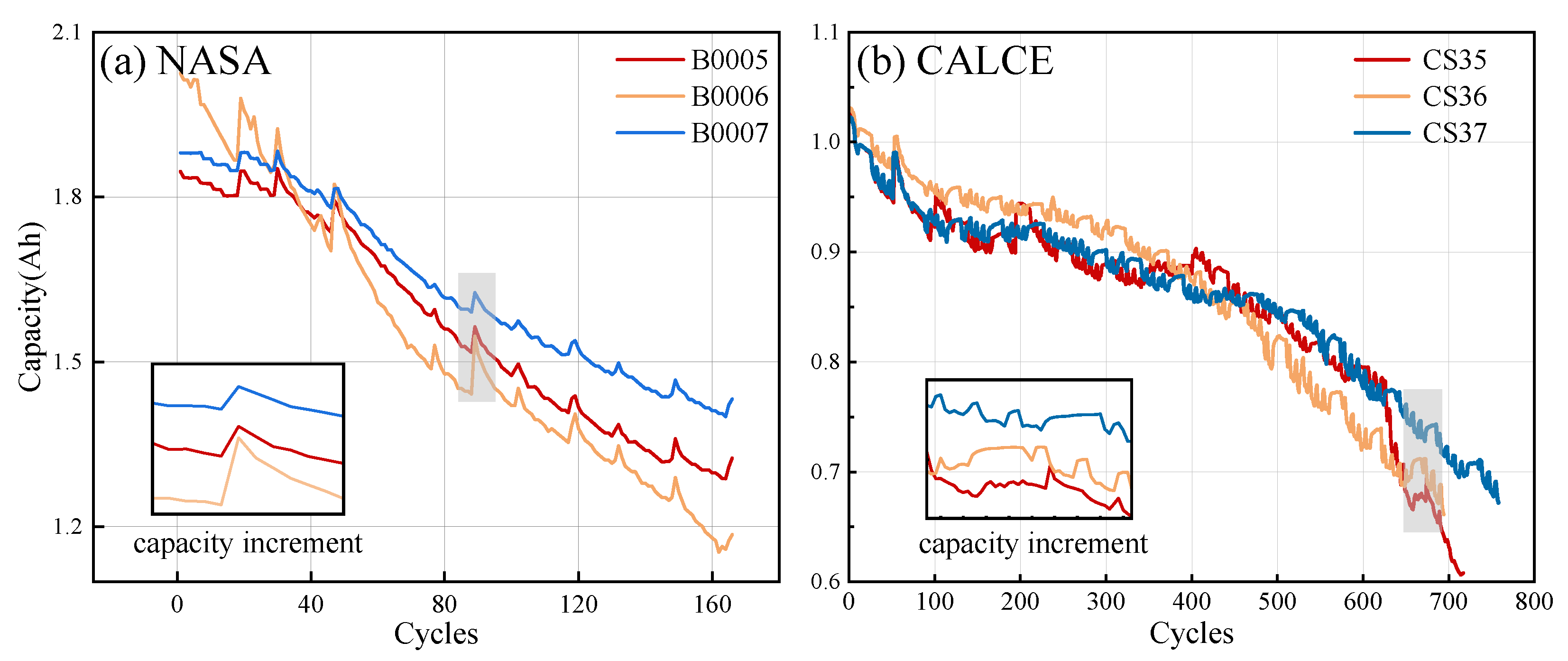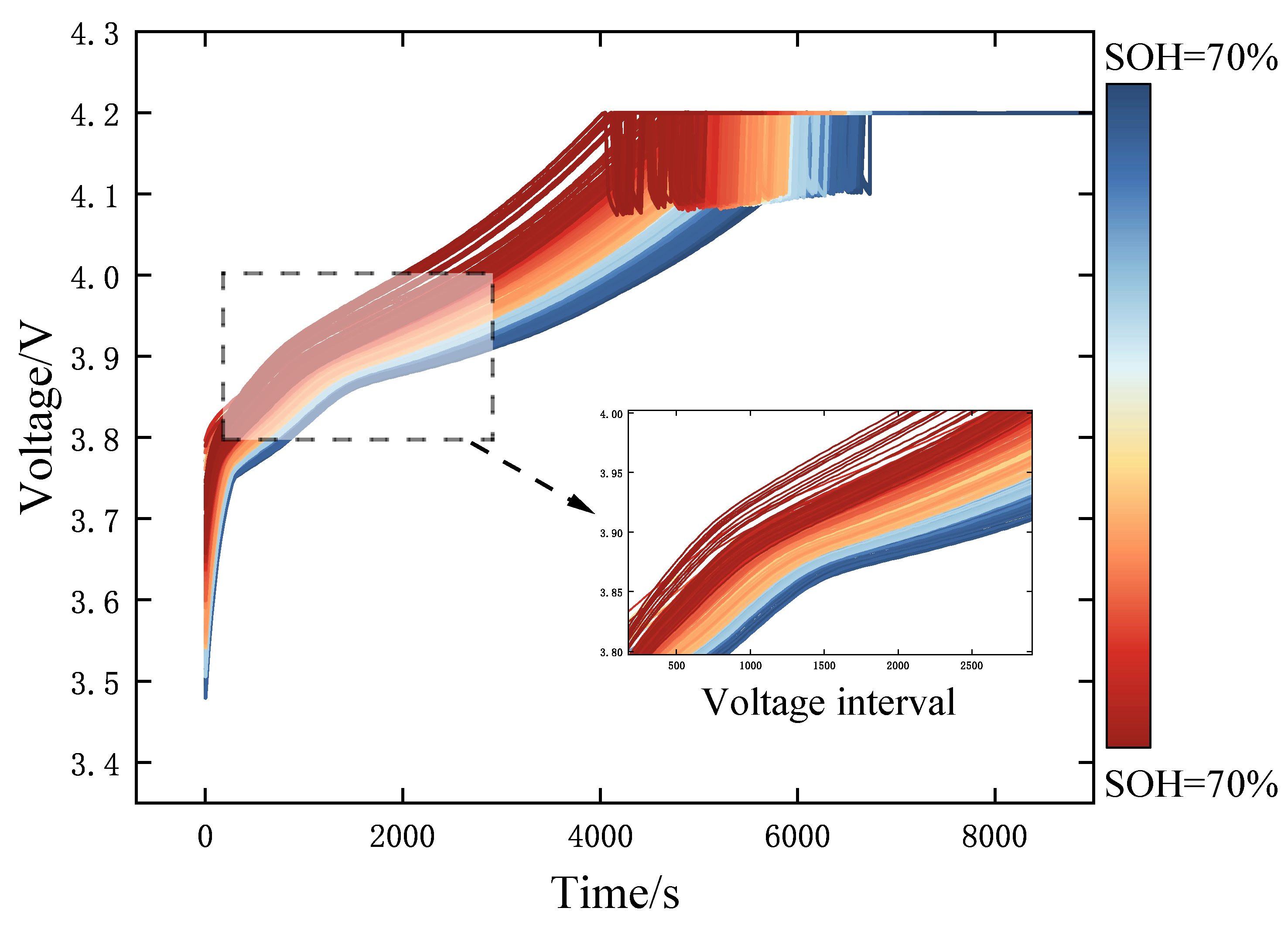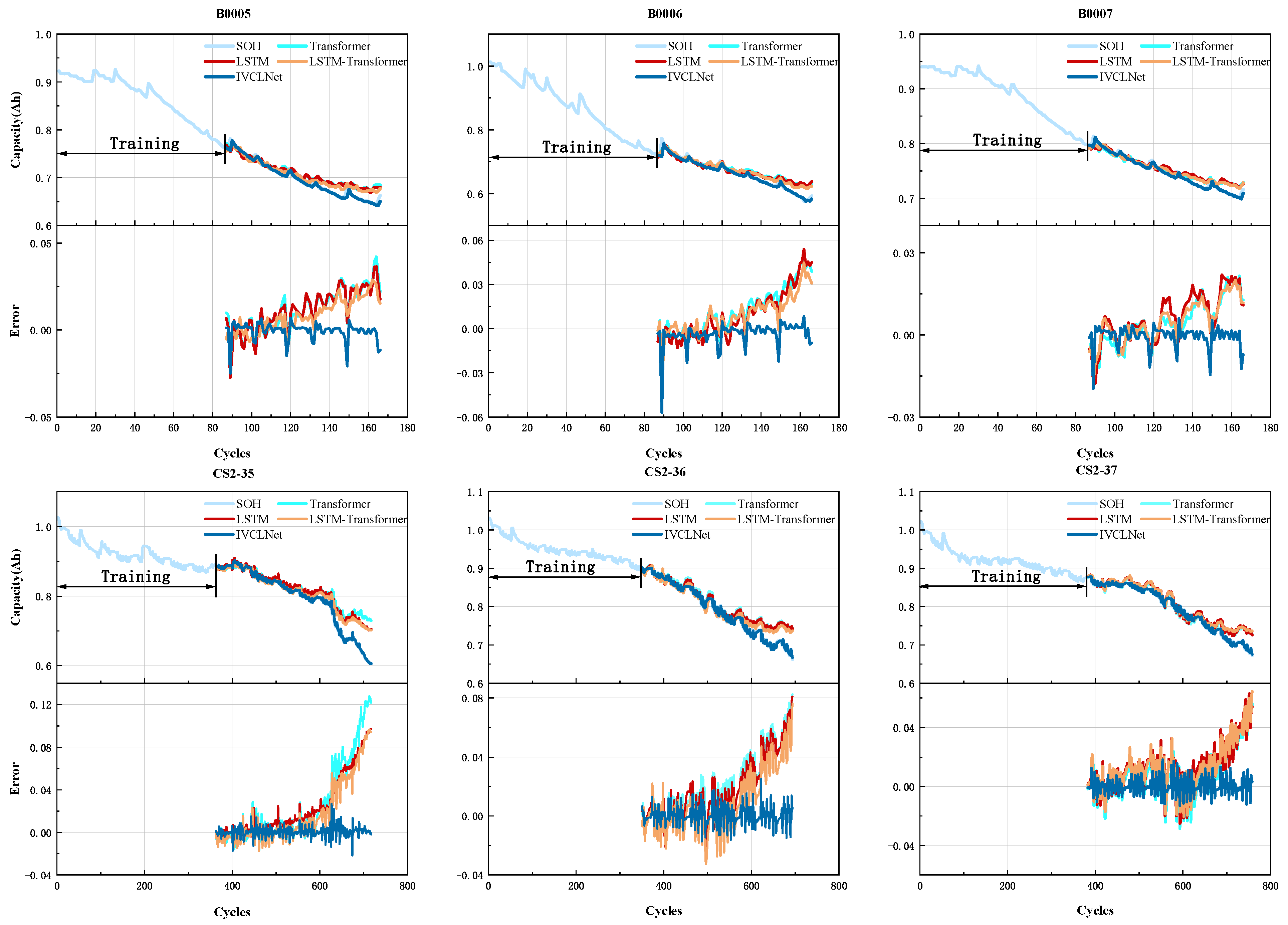IVCLNet: A Hybrid Deep Learning Framework Integrating Signal Decomposition and Attention-Enhanced CNN-LSTM for Lithium-Ion Battery SOH Prediction and RUL Estimation
Abstract
1. Introduction
- A novel hybrid framework, IVCLNet, is proposed. It employs ICEEMDAN and VMD for multi-level signal decomposition and utilizes a fusion model to learn time-series degradation features. This design enhances the modeling of complex non-stationary signals and improves RUL prediction accuracy.
- A hybrid input strategy is designed by integrating indirect health indicators and decomposed capacity features, boosting feature sensitivity and predictive robustness.
- A CNN-LSTM network enhanced by a Convolutional Block Attention Module (CBAM) is introduced to adaptively extract key temporal features. Experiments demonstrate that IVCLNet outperforms baseline models in both accuracy and robustness.
2. Method
2.1. Improved CEEMDAN (ICEEMDAN)
2.2. Variational Mode Decomposition (VMD)
2.3. Temporal Feature Modeling: CNN and LSTM Integration
2.4. Key Feature Enhancement Mechanism: Convolutional Block Attention Module (CBAM)
2.5. Fusion Prediction Framework IVCLNet
3. Health Feature Extraction and Processing
3.1. Data Description
3.1.1. NASA Lithium Battery Dataset
3.1.2. CALCE Lithium Battery Dataset
3.2. Health Indicator Extraction
3.3. Dataset Decomposition
4. Experiments and Analysis
4.1. The Evaluation Criteria
4.2. SOH Prediction and RUL Estimation
4.2.1. Hyperparameter Setting
4.2.2. Comparison of the NASA and CALCE Datasets
4.2.3. Potential Health Indicators Under Varying Conditions
4.2.4. Efficiency Comparison
- Floating-point operations (FLOPs), which quantify the computational complexity of a single forward pass.
- Training time, which reflects the actual runtime required for model convergence.
- Number of parameters, indicating the total trainable weights and thus memory demand.
- Storage size, representing the practical deployment cost on edge devices.
4.2.5. Ablation Experiment
5. Conclusions
Author Contributions
Funding
Data Availability Statement
Conflicts of Interest
References
- Lipu, M.H.; Hannan, M.A.; Hussain, A.; Hoque, M.M.; Ker, P.J.; Saad, M.H.M.; Ayob, A. A review of state of health and remaining useful life estimation methods for lithium-ion battery in electric vehicles: Challenges and recommendations. J. Clean. Prod. 2018, 205, 115–133. [Google Scholar] [CrossRef]
- Zio, E. Prognostics and health management (PHM): Where are we and where do we (need to) go in theory and practice. Reliab. Eng. Syst. Saf. 2022, 218, 108119. [Google Scholar] [CrossRef]
- Zhao, X.; Cai, Y.; Yang, L.; Deng, Z.; Qiang, J. State of charge estimation based on a new dual-polarization-resistance model for electric vehicles. Energy 2017, 135, 40–52. [Google Scholar] [CrossRef]
- Xu, Z.; Wang, J.; Lund, P.D.; Zhang, Y. Co-estimating the state of charge and health of lithium batteries through combining a minimalist electrochemical model and an equivalent circuit model. Energy 2022, 240, 122815. [Google Scholar] [CrossRef]
- Guha, A.; Patra, A. Online estimation of the electrochemical impedance spectrum and remaining useful life of lithium-ion batteries. IEEE Trans. Instrum. Meas. 2018, 67, 1836–1849. [Google Scholar] [CrossRef]
- Lui, Y.H.; Li, M.; Downey, A.; Shen, S.; Nemani, V.P.; Ye, H.; VanElzen, C.; Jain, G.; Hu, S.; Laflamme, S.; et al. Physics-based prognostics of implantable-grade lithium-ion battery for remaining useful life prediction. J. Power Sources 2021, 485, 229327. [Google Scholar] [CrossRef]
- Xue, A.; Yang, W.; Yuan, X.; Yu, B.; Pan, C. Estimating state of health of lithium-ion batteries based on generalized regression neural network and quantum genetic algorithm. Appl. Soft Comput. 2022, 130, 109688. [Google Scholar] [CrossRef]
- Ji, Y.; Chen, Z.; Shen, Y.; Yang, K.; Wang, Y.; Cui, J. An RUL prediction approach for lithium-ion battery based on SADE-MESN. Appl. Soft Comput. 2021, 104, 107195. [Google Scholar] [CrossRef]
- Xu, H.; Wu, L.; Xiong, S.; Li, W.; Garg, A.; Gao, L. An improved CNN-LSTM model-based state-of-health estimation approach for lithium-ion batteries. Energy 2023, 276, 127585. [Google Scholar] [CrossRef]
- Zhang, Y.; Chen, L.; Li, Y.; Zheng, X.; Chen, J.; Jin, J. A hybrid approach for remaining useful life prediction of lithium-ion battery with adaptive levy flight optimized particle filter and long short-term memory network. J. Energy Storage 2021, 44, 103245. [Google Scholar] [CrossRef]
- Zhao, S.; Zhang, C.; Wang, Y. Lithium-ion battery capacity and remaining useful life prediction using broad learning system and long short-term memory neural network. J. Energy Storage 2022, 52, 104901. [Google Scholar] [CrossRef]
- Wang, Z.; Liu, N.; Guo, Y. Adaptive sliding window LSTM NN based RUL prediction for lithium-ion batteries integrating LTSA feature reconstruction. Neurocomputing 2021, 466, 178–189. [Google Scholar] [CrossRef]
- Liu, Y.; Sun, J.; Shang, Y.; Zhang, X.; Ren, S.; Wang, D. A novel remaining useful life prediction method for lithium-ion battery based on long short-term memory network optimized by improved sparrow search algorithm. J. Energy Storage 2023, 61, 106645. [Google Scholar] [CrossRef]
- Ren, L.; Dong, J.; Wang, X.; Meng, Z.; Zhao, L.; Deen, M.J. A data-driven auto-CNN-LSTM prediction model for lithium-ion battery remaining useful life. IEEE Trans. Ind. Inform. 2020, 17, 3478–3487. [Google Scholar] [CrossRef]
- Mo, Y.; Li, Q.; Karimian, H.; Fang, S.; Tang, B.; Chen, G.; Sachdeva, S. A novel framework for daily forecasting of ozone mass concentrations based on cycle reservoir with regular jumps neural networks. Atmos. Environ. 2020, 220, 117072. [Google Scholar] [CrossRef]
- Qi, X.; Hong, C.; Ye, T.; Gu, L.; Wu, W. Frequency reconstruction oriented EMD-LSTM-AM based surface temperature prediction for lithium-ion battery. J. Energy Storage 2024, 84, 111001. [Google Scholar] [CrossRef]
- Wu, Z.; Huang, N.E. Ensemble empirical mode decomposition: A noise-assisted data analysis method. Adv. Adapt. Data Anal. 2009, 1, 1–41. [Google Scholar] [CrossRef]
- Yeh, J.-R.; Shieh, J.-S.; Huang, N.E. Complementary ensemble empirical mode decomposition: A novel noise enhanced data analysis method. Adv. Adapt. Data Anal. 2010, 2, 135–156. [Google Scholar] [CrossRef]
- Torres, M.E.; Colominas, M.A.; Schlotthauer, G.; Flandrin, P. A complete ensemble empirical mode decomposition with adaptive noise. In Proceedings of the 2011 IEEE International Conference on Acoustics, Speech and Signal Processing (ICASSP), Prague, Czech Republic, 22–27 May 2011; pp. 4144–4147. [Google Scholar]
- Colominas, M.A.; Schlotthauer, G.; Torres, M.E. Improved complete ensemble EMD: A suitable tool for biomedical signal processing. Biomed. Signal Process. Control 2014, 14, 19–29. [Google Scholar] [CrossRef]
- Dragomiretskiy, K.; Zosso, D. Variational mode decomposition. IEEE Trans. Signal Process. 2013, 62, 531–544. [Google Scholar] [CrossRef]
- Krizhevsky, A.; Sutskever, I.; Hinton, G.E. Imagenet classification with deep convolutional neural networks. Commun. ACM 2017, 60, 84–90. [Google Scholar] [CrossRef]
- Hoseinzade, E.; Haratizadeh, S.; Khoeini, A. U-CNNpred: A universal CNN-based predictor for stock markets. arXiv 2019, arXiv:1911.12540. [Google Scholar]
- Hochreiter, S.; Schmidhuber, J. Long short-term memory. Neural Comput. 1997, 9, 1735–1780. [Google Scholar] [CrossRef] [PubMed]
- Woo, S.; Park, J.; Lee, J.-Y.; Kweon, I.S. CBAM: Convolutional block attention module. In Proceedings of the European Conference on Computer Vision (ECCV), Munich, Germany, 8–14 September 2018; pp. 3–19. [Google Scholar]
- Saha, B.; Goebel, K. Modeling Li-ion battery capacity depletion in a particle filtering framework. In Proceedings of the Annual Conference of the PHM Society 2009, San Diego, CA, USA, 27 September–1 October 2009; pp. 1–9. [Google Scholar]
- Liu, D.; Zhou, J.; Liao, H.; Peng, Y.; Peng, X. A health indicator extraction and optimization framework for lithium-ion battery degradation modeling and prognostics. IEEE Trans. Syst. Man Cybern. Syst. 2015, 45, 915–928. [Google Scholar]
- Liu, H.; Naqvi, I.H.; Li, F.; Liu, C.; Shafiei, N.; Li, Y.; Pecht, M. An analytical model for the CC-CV charge of Li-ion batteries with application to degradation analysis. J. Energy Storage 2020, 29, 101342. [Google Scholar] [CrossRef]
- Shen, J.-N.; Shen, J.-J.; He, Y.-J.; Ma, Z.-F. Accurate state of charge estimation with model mismatch for Li-ion batteries: A joint moving horizon estimation approach. IEEE Trans. Power Electron. 2018, 34, 4329–4342. [Google Scholar] [CrossRef]
- Liu, D.; Xie, W.; Liao, H.; Peng, Y. An integrated probabilistic approach to lithium-ion battery remaining useful life estimation. IEEE Trans. Instrum. Meas. 2014, 64, 660–670. [Google Scholar] [CrossRef]
- Jameel, S.M.; Altmemi, J.; Oglah, A.A.; Abbas, M.A.; Sabry, A.H. Predicting batteries second-life state-of-health with first-life data and on-board voltage measurements using support vector regression. J. Energy Storage 2024, 104, 114554. [Google Scholar] [CrossRef]
- Kwon, S.; Han, D.; Park, J.; Lee, P.-Y.; Kim, J. Joint state-of-health and remaining-useful-life prediction based on multi-level long short-term memory model prognostic framework considering cell voltage inconsistency reflected health indicators. J. Energy Storage 2022, 55, 105731. [Google Scholar] [CrossRef]
- Roman, D.; Saxena, S.; Robu, V.; Pecht, M.; Flynn, D. Machine learning pipeline for battery state-of-health estimation. Nat. Mach. Intell. 2021, 3, 447–456. [Google Scholar] [CrossRef]





| Battery Series | CCDT | CCCT | CVCT | TIECVD | TIEDVD | MVF |
|---|---|---|---|---|---|---|
| B0005 | 0.9999 | 0.9980 | −0.9735 | 0.9971 | 0.9989 | −0.9859 |
| B0006 | 0.9999 | 0.9948 | −0.9697 | 0.9928 | 0.9958 | −0.9655 |
| B0007 | 0.9999 | 0.9980 | −0.9845 | 0.9918 | 0.9988 | −0.9668 |
| CS2-35 | 0.9999 | 0.9967 | −0.9833 | 0.9954 | 0.9774 | −0.9540 |
| CS2-36 | 0.9999 | 0.9976 | −0.9938 | 0.9960 | 0.9815 | −0.9780 |
| CS2-37 | 0.9999 | 0.9968 | −0.9649 | 0.9956 | 0.9771 | −0.9370 |
| Models | Training Hyperparameters | Model Hyperparameters | ||||
|---|---|---|---|---|---|---|
| IVCLNet | 300 | 0.001 | 25 | - | 32 | 2 |
| Transformer | 300 | 0.001 | 25 | 64 | 32 | 2 |
| LSTM | 300 | 0.001 | 25 | - | 32 | 2 |
| LSTM-Transformer | 300 | 0.001 | 25 | 64 | 32 | 2 |
| IVCLNet | Transformer | LSTM | LSTM-TF |
|---|---|---|---|
| Input | Input | Input | Input |
| Conv1D(1 × 3, 32) | Embed layer (32) | Linear | LSTM(64) |
| BN + ReLU | Positional Encoder | LSTM(32) | LSTM(32) |
| CBAM Attention | Softmax Attention | LSTM(32) | Softmax Attention |
| LSTM(64) | Add&Norm | LSTM(32) | Add&Norm |
| LSTM(32) | Softmax Attention | Linear | Feedforward |
| Linear | Add&Norm | Linear | |
| MLP | |||
| Add&Norm |
| Cell | Methods | MAE | RMSE | MSE | MAPE | |
|---|---|---|---|---|---|---|
| B0005 | IVCLNet | 0.0030 | 0.0052 | 0.0001 | 0.0043 | 0.9803 |
| Transformer | 0.0139 | 0.0169 | 0.0002 | 0.0206 | 0.8127 | |
| LSTM | 0.0139 | 0.0165 | 0.0002 | 0.0205 | 0.8197 | |
| LSTM-Transformer | 0.0100 | 0.0126 | 0.0001 | 0.0148 | 0.8906 | |
| B0006 | IVCLNet | 0.0048 | 0.0089 | 0.0001 | 0.0071 | 0.9641 |
| Transformer | 0.0154 | 0.0201 | 0.0004 | 0.0244 | 0.8288 | |
| LSTM | 0.0147 | 0.0198 | 0.0003 | 0.0234 | 0.8303 | |
| LSTM-Transformer | 0.0119 | 0.0159 | 0.0002 | 0.0189 | 0.8901 | |
| B0007 | IVCLNet | 0.0026 | 0.0041 | 0.0001 | 0.0035 | 0.9805 |
| Transformer | 0.0075 | 0.0095 | 0.0001 | 0.0103 | 0.9002 | |
| LSTM | 0.0089 | 0.0109 | 0.0001 | 0.0121 | 0.8715 | |
| LSTM-Transformer | 0.0073 | 0.0090 | 0.0001 | 0.0099 | 0.9114 | |
| CS2-35 | IVCLNet | 0.0032 | 0.0048 | 0.0001 | 0.0042 | 0.9966 |
| Transformer | 0.0277 | 0.0446 | 0.0019 | 0.0401 | 0.7359 | |
| LSTM | 0.0233 | 0.0360 | 0.0012 | 0.0336 | 0.8266 | |
| LSTM-Transformer | 0.0212 | 0.0336 | 0.0011 | 0.0305 | 0.8441 | |
| CS2-36 | IVCLNet | 0.0041 | 0.0058 | 0.0001 | 0.0054 | 0.9927 |
| Transformer | 0.0224 | 0.0300 | 0.0009 | 0.0306 | 0.8267 | |
| LSTM | 0.0204 | 0.0277 | 0.0007 | 0.0278 | 0.8476 | |
| LSTM-Transformer | 0.0171 | 0.0233 | 0.0005 | 0.0231 | 0.8879 | |
| CS2-37 | IVCLNet | 0.0032 | 0.0046 | 0.0001 | 0.0042 | 0.9940 |
| Transformer | 0.0133 | 0.0184 | 0.0003 | 0.0177 | 0.9089 | |
| LSTM | 0.0155 | 0.0202 | 0.0004 | 0.0206 | 0.8922 | |
| LSTM-Transformer | 0.0156 | 0.0205 | 0.0004 | 0.0207 | 0.8892 |
| Models | FLOPs (Million) | Training Time (s) | Parameters | Storage Size (KB) |
|---|---|---|---|---|
| IVCLNet | 0.52 | 11.2 | 9843 | 42.7 |
| Transformer | 0.31 | 13.9 | 7215 | 46.3 |
| LSTM | 0.27 | 8.9 | 6527 | 38.1 |
| LSTM-Transformer | 0.61 | 15.3 | 11,492 | 55.2 |
| Model Variant | MAE | MSE | RMSE | MAPE (%) | |
|---|---|---|---|---|---|
| w/o ICEEMDAN | 0.0089 | 1.21 | 0.0110 | 1.92 | 0.897 |
| w/o VMD | 0.0067 | 6.58 | 0.0081 | 1.46 | 0.925 |
| w/o CBAM | 0.0054 | 4.10 | 0.0064 | 1.21 | 0.946 |
| IVCLNet | 0.0035 | 2.70 | 0.0052 | 0.65 | 0.974 |
Disclaimer/Publisher’s Note: The statements, opinions and data contained in all publications are solely those of the individual author(s) and contributor(s) and not of MDPI and/or the editor(s). MDPI and/or the editor(s) disclaim responsibility for any injury to people or property resulting from any ideas, methods, instructions or products referred to in the content. |
© 2025 by the authors. Licensee MDPI, Basel, Switzerland. This article is an open access article distributed under the terms and conditions of the Creative Commons Attribution (CC BY) license (https://creativecommons.org/licenses/by/4.0/).
Share and Cite
Pei, Y.; Huo, H.; Guo, Y.; Kang, S.; Xu, J. IVCLNet: A Hybrid Deep Learning Framework Integrating Signal Decomposition and Attention-Enhanced CNN-LSTM for Lithium-Ion Battery SOH Prediction and RUL Estimation. Energies 2025, 18, 5677. https://doi.org/10.3390/en18215677
Pei Y, Huo H, Guo Y, Kang S, Xu J. IVCLNet: A Hybrid Deep Learning Framework Integrating Signal Decomposition and Attention-Enhanced CNN-LSTM for Lithium-Ion Battery SOH Prediction and RUL Estimation. Energies. 2025; 18(21):5677. https://doi.org/10.3390/en18215677
Chicago/Turabian StylePei, Yulong, Hua Huo, Yinpeng Guo, Shilu Kang, and Jiaxin Xu. 2025. "IVCLNet: A Hybrid Deep Learning Framework Integrating Signal Decomposition and Attention-Enhanced CNN-LSTM for Lithium-Ion Battery SOH Prediction and RUL Estimation" Energies 18, no. 21: 5677. https://doi.org/10.3390/en18215677
APA StylePei, Y., Huo, H., Guo, Y., Kang, S., & Xu, J. (2025). IVCLNet: A Hybrid Deep Learning Framework Integrating Signal Decomposition and Attention-Enhanced CNN-LSTM for Lithium-Ion Battery SOH Prediction and RUL Estimation. Energies, 18(21), 5677. https://doi.org/10.3390/en18215677





